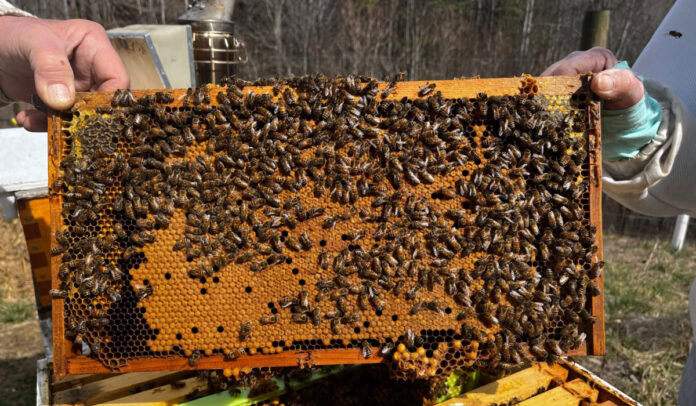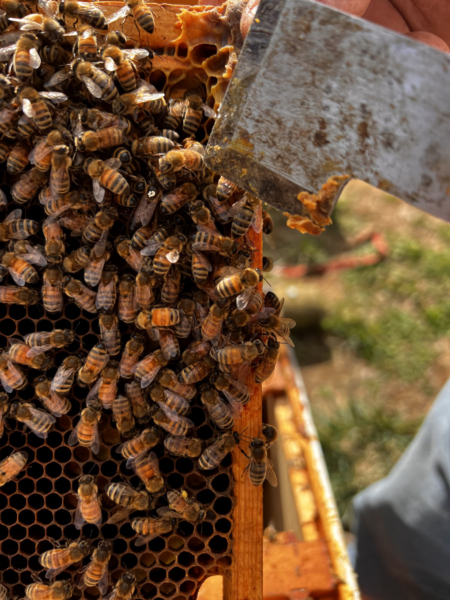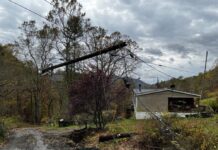
A couple of fellow beekeepers came over today and we did a deep inspection of my beehives. All six were full of bees, honey, fresh nectar, and pollen. They look very good for this early in the year. All were queen-right, and are not in danger of starving. It was nice to get a second opinion, as no other beekeeper had ever seen my hives before.
You may remember that I had one hive die last winter. They had plenty of food, but no queen. So far, all this year’s hives have successfully over wintered.
I expected the warm winter would mean many beekeepers had high over winter rates, but that was not the case. At our recent beekeeper association meeting, about half of the beekeepers had lost hives, some multiple hives.
This is why I treat for mites after I pull the honey off the hives, and I feed my bees heading into winter. A few bags of sugar can save hundreds of dollars’ worth of bees.
Queens, Eggs and Brood
We not only opened and looked into every beehive, we pulled and inspected multiple frames in every box, making sure each hive had plenty of food and eggs. Spotting eggs means you have an active, laying queen. While all hives had brood in all stages, we also spotted the queen in two different hives.

As you can see in the photo above this article, there were many full frames of brood, meaning there will be thousands of new bees hatching in the next week. These new bees will become foragers three weeks after they emerge. The hives will be ready to harvest large amounts of nectar in early April, which is a bit early for our normal spring honey flow, so I will hope for an early and lengthy run producing lots of honey.
We also lifted each hive body off the bottom board and scraped the boards clean. In four of the hives, we swapped the order of the hive bodies, putting the top one on the bottom. We also checkerboarded a few frames. This gives the bees room to move upwards and will make them less likely to swarm.
Cold Weather Coming?
While the bees and many of the local plants they rely on are off to an early start, the long-range forecast is for the rest of March to be cooler than the last few weeks. They expect temperatures to dip back into the 20s some nights. I expect the bees will “weather” the cold just fine, but it may kill off some blooms on which they are feeding. Our maple trees, for example, are blooming, giving the bees an early source of both pollen and nectar. These trees can bloom for a month, providing much-needed nutrition early in the spring.
It won’t be a problem if we have some scattered nights of cold. If we get a period of prolonged cold weather, the bees will eat their honey, but the plants could lose their buds and future seeds or fruit. That will be bad for the bees and other animals that depend on the trees as a food source.
Thankfully, very few of our flowering shrubs have gotten anywhere close to flowering. There are also few spring ephemerals up yet. My gut says the vast majority of the plants will be fine if we get some cold. Meanwhile, cold days will give me time to do inside work, like building more beehives and frames.
Bees and War
Maybe some of you are out there thinking, “Why are you talking about bees when the world is moving closer to war every day? There are Russian nuclear subs off our coast, Chinese leader Xi Jinping is blaming the U.S. for keeping China down, and it looks like Iran and Israel are going to come to blows. We should be prepping for that!”
True, but there’s nothing I can do about China, Russia or Iran. I am better off focusing on things I can control and preps I can make. Bees happen to be one of them. I’m not going to let my hives die because Putin’s on the warpath and Xi has a tirade. Likewise, I cleaned out the chicken coop and gave them fresh bedding over the weekend. Getting fresh eggs is a prep, too, but more importantly, if we let the threat of war stop us from taking care of business, nothing would ever get done. We’re also planning the garden and starting plants indoors. Life goes on.
The war in Ukraine is now a year old. Any emergency preps I made in response are complete. Nonetheless, I am still making small preps. The last time I was at the store, I bought two cans of Hormel chili, which is a step down from buying the eight or more I would have picked up a year ago. Two cans cost less than $5, but when served over a plate of rice, it makes a good meal for two people. It also doesn’t faze my budget.
Ongoing Preps
Although they are important, there is more to prepping than accumulating and stockpiling.
For example, this weekend, I tore down my EDC bag and went through every pocket and pouch, making sure I knew where everything was. I recharged the 18650 batteries and electronic devices in it, and made sure that the contents were in good shape, especially the first aid items. Given the growing importance of electric devices, I also added a charger that will fit in a car power port, which people my age know as a cigarette lighter. I can now plug two standard USB cables and two of the newer USB-C cable into it and charge my phone and flashlight from any available vehicle, even older vehicles that do not have USB ports.
Here are other prepping-related things you can do that cost nothing: Make sure the survival gear you carry in your car is good and adjust it with the seasons. (I remember one year when a baggie of Jolly Ranchers melted into a solid lump. That was a lesson learned.) Take an inventory of your prepper pantry, rotating out anything old and replenishing anything you used up. Check and consider rotating out your stored water. Make sure your firearms are lubed and the batteries in your lights and optics work. Fire up your generator, chain saw and other small engines every two months or so to ensure they run and the carburetor isn’t gummed up.
I’m sure you can think of more. The trick is, don’t get complacent, don’t give up because things look desperate, and don’t despair that you don’t have more money or stockpiles. Prepping is a journey. Sometimes you move fast, sometimes you go slow. Just stay on the road and keep putting one foot in front of the other.







